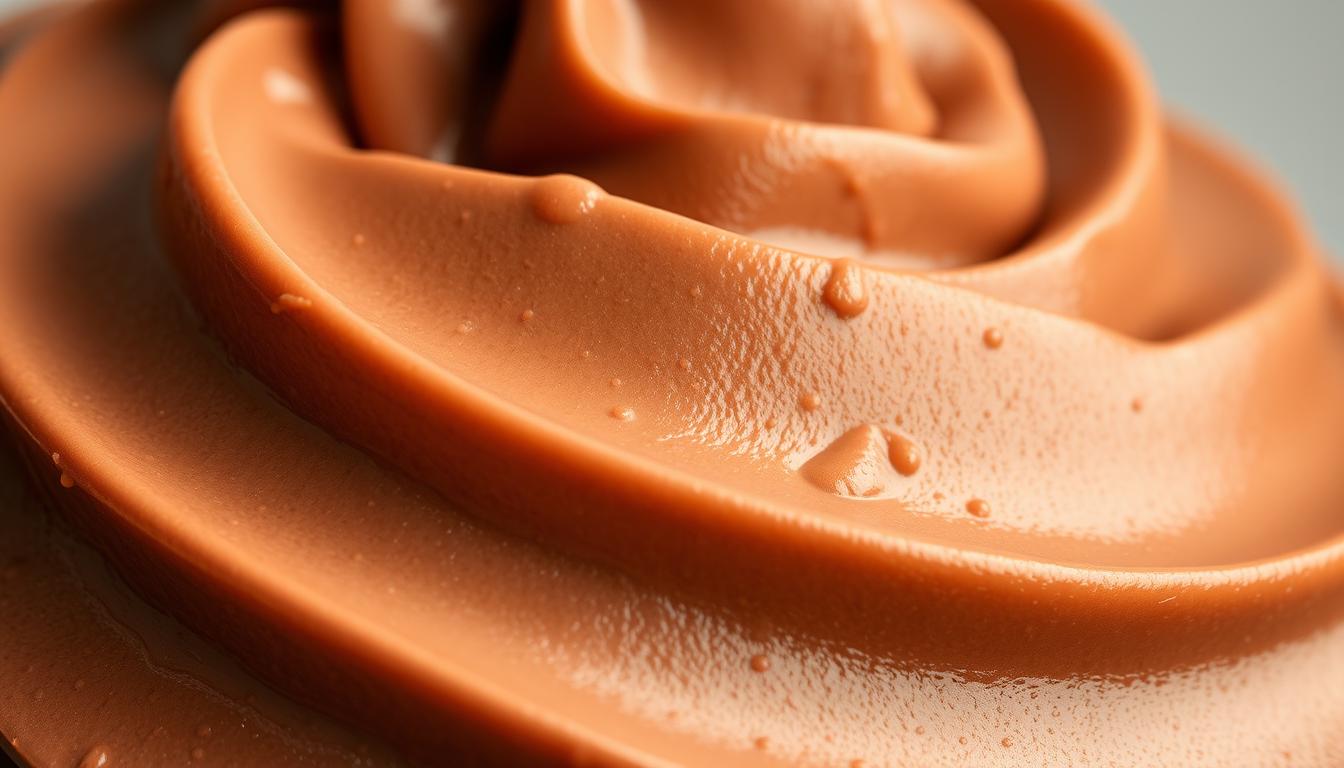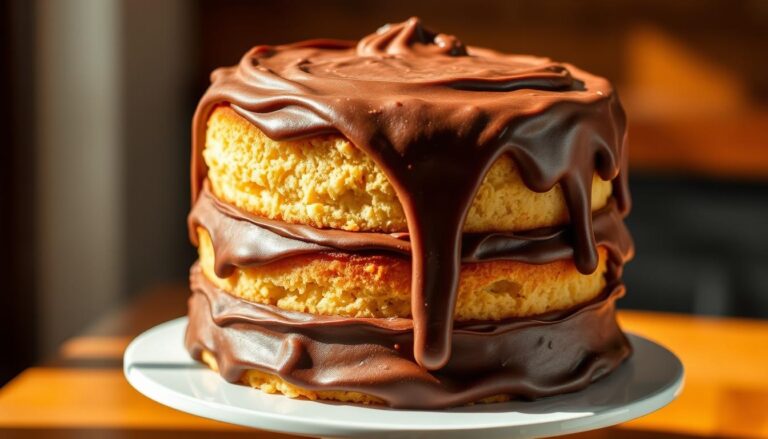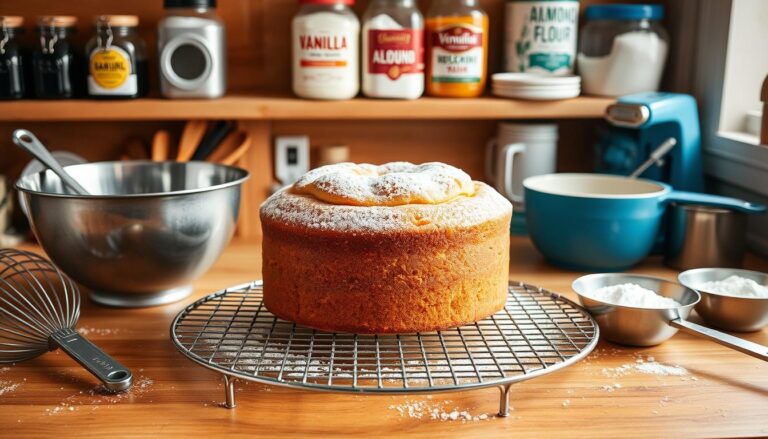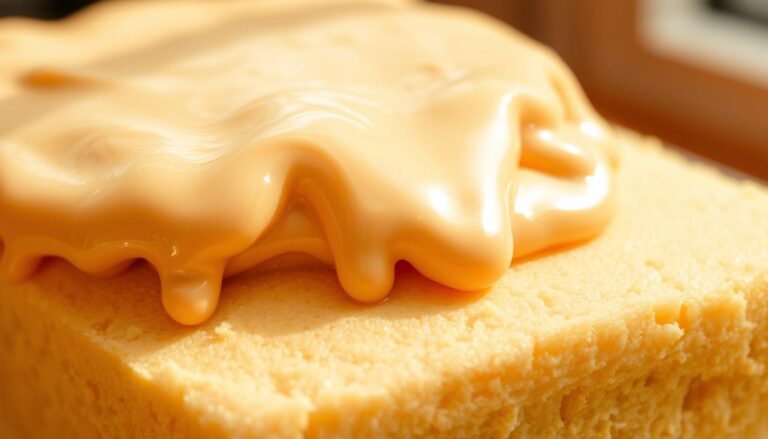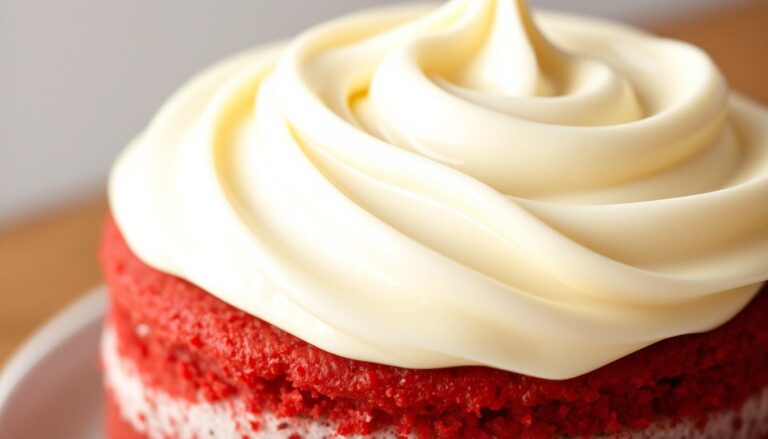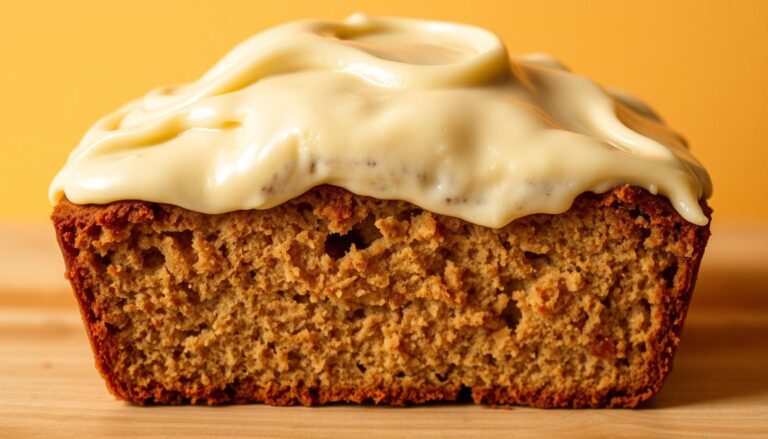Tips for the best chocolate cream cheese frosting texture
Every baker knows the magic of a perfect chocolate cream cheese frosting. It turns an ordinary cake into an extraordinary dessert. I remember the first time I got the silky-smooth texture that makes people close their eyes in delight.
Creating the ultimate cream cheese icing is an art form. It takes your baking from good to unforgettable. Your journey to mastering chocolate cream cheese frosting starts with understanding the delicate balance between ingredients and technique.
Whether you’re a home baker or aspiring pastry chef, this guide will unlock the secrets. You’ll learn how to create a frosting that’s creamy, rich, and irresistible.
Achieving the perfect chocolate cream cheese frosting isn’t about luck. It’s about precision, technique, and understanding how ingredients interact. Get ready to transform your desserts with a frosting that will have everyone asking for your recipe.
Table of Contents
Understanding the Basics of Cream Cheese Frosting
To make the perfect chocolate cheesecake frosting, you need to know its basics. Start by understanding the key ingredients that make it special. This knowledge will help you create a luxurious topping for your cheesecake.
The Science Behind Perfect Frosting Consistency
Getting the right texture for your frosting is all about fat emulsification. The mix of cream cheese and butter makes it smooth and stable. This ensures your frosting spreads well and keeps its shape.
- Fat content determines structural integrity
- Proper emulsification prevents separation
- Molecular bonds create creamy texture
Essential Ingredients Overview
| Ingredient | Purpose | Recommended Quantity |
|---|---|---|
| Cream Cheese | Primary Base | 8 oz |
| Unsalted Butter | Richness & Texture | 1/2 cup |
| Powdered Sugar | Sweetness & Structure | 2 cups |
| Cocoa Powder | Chocolate Flavor | 1/4 cup |
Temperature Considerations
The success of your frosting depends on the temperature of your ingredients. Room temperature ingredients mix better, avoiding lumps. This makes your frosting silky and smooth.
- Cream cheese: 70°F (softened)
- Butter: Slightly cool but pliable
- Avoid cold ingredients that cause separation
Choosing the Right Type of Cream Cheese
Choosing the right cream cheese is key to a perfect chocolate ganache frosting. Not all cream cheese is the same. Knowing the differences is important for a smooth, rich frosting.
Professional bakers say full-fat cream cheese blocks are best. They have more fat, less moisture, and a stable structure. This makes the frosting better.
Look for cream cheese with:
- At least 33% milk fat
- A smooth, dense texture
- No added stabilizers or gums
- Consistent quality
When shopping, check the packaging. Philadelphia and Kraft are good brands for frosting. Avoid low-fat or reduced-fat cream cheese. It can make your frosting less rich and stable.
Keep your cream cheese in the fridge. Let it warm up to room temperature before mixing. This will give you the smoothest frosting for your chocolate ganache.
The Importance of Quality Cocoa Powder
Creating a rich chocolate frosting starts with the right cocoa powder. Your decadent cream cheese topping depends on knowing the different cocoa varieties and how to prepare them.
Cocoa powder is the heart of any chocolate-based dessert topping. Not all cocoa powders are the same. Your choice can greatly affect the flavor and texture of your frosting.
Dutch Process vs Natural Cocoa
The two main types of cocoa powder can change your frosting:
- Dutch-processed cocoa: Made smoother with an alkaline solution, it has a less acidic flavor
- Natural cocoa: Has a more intense, slightly bitter taste with higher acidity
Measuring and Sifting Techniques
When working with cocoa powder, precision is key. Proper measuring is essential for consistent results:
- Use standard measuring cups for dry ingredients
- Sift cocoa powder to remove lumps
- Level off measurements with a straight edge
Impact on Final Texture
The quality of your cocoa powder affects the frosting’s smoothness and flavor. High-quality cocoa makes the frosting luxurious and velvety, improving your dessert.
Pro tip: Always invest in premium cocoa powder for the most exceptional rich chocolate frosting.
Proper Mixing Techniques for Chocolate Cream Cheese Frosting
Making the perfect chocolate cream cheese spread needs careful mixing. Your mixing method can greatly affect the frosting’s texture and taste. Knowing the right steps will improve your baking and give you a top-notch result.
Begin by making sure your ingredients are at room temperature. Cold ingredients can lead to a lumpy spread. Follow these essential mixing steps:
- Cream the butter first for 2-3 minutes until light and fluffy
- Add room temperature cream cheese and beat for 1 minute
- Gradually incorporate sifted cocoa powder
- Slowly add powdered sugar while mixing
The tool you use can change your spread’s consistency. A stand mixer gives the best results, but a hand mixer is good for smaller amounts. Whisking by hand is harder but can work if needed.
| Mixing Tool | Pros | Cons |
|---|---|---|
| Stand Mixer | Consistent mixing | Expensive |
| Hand Mixer | Affordable, portable | Less powerful |
| Whisk | No electricity needed | Requires more physical effort |
Pro tip: Avoid overmixing, which can introduce air bubbles and create a less smooth texture. Stop mixing as soon as ingredients are fully incorporated.
“Precision in mixing is the secret to a perfect chocolate cream cheese spread.” – Professional Pastry Chef
Temperature Control and Room Temperature Ingredients
Making the perfect chocolate cream cheese frosting depends a lot on the temperature of your ingredients. Knowing how temperature affects your frosting can make it smooth and creamy or a letdown.
Getting the right temperature is key for a silky-smooth frosting. Make sure your ingredients are at the right temperature for the best results.
Optimal Butter Softness
Butter is a key part of your frosting. For the best results, your butter should be just right:
- Let butter sit at room temperature for 30-45 minutes
- Butter should be soft but not melted
- Press gently – it should leave an indent without breaking
Cream Cheese Temperature Guide
| Temperature Range | Cream Cheese Condition | Impact on Frosting |
|---|---|---|
| 35-45°F (Cold) | Firm and Stiff | Lumpy, difficult to mix |
| 65-70°F (Room Temperature) | Soft and Pliable | Smooth, creamy texture |
| 75-80°F (Warm) | Soft and Greasy | Runny, loses structure |
Environmental Considerations
The temperature in your kitchen can really affect your frosting. In warmer kitchens, work fast and chill ingredients to keep the right consistency.
- Use a cool countertop or marble surface
- Work in an air-conditioned space if possible
- Avoid drafty or extremely warm areas
Achieving the Perfect Sweetness Balance
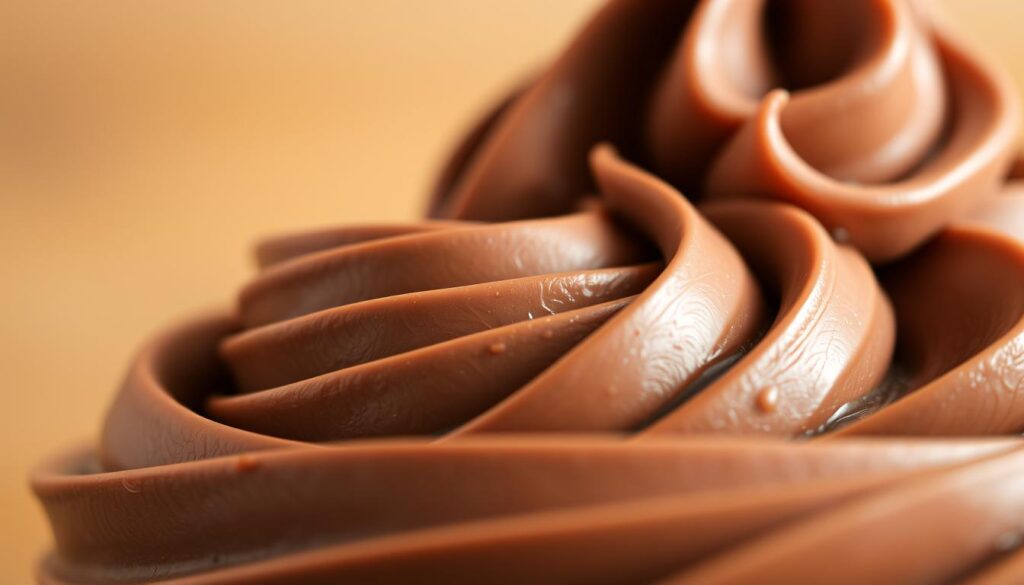
Making the perfect chocolate cheesecake frosting is all about finding the right balance. It’s about mixing flavors that make your taste buds dance. The trick is to add sweetness without drowning out the chocolate.
To make your rich chocolate frosting, start by adding powdered sugar slowly. This lets you control how sweet it gets. Every cake or dessert is different, so they need different amounts of sweetness.
- Taste as you go to prevent over-sweetening
- Use high-quality powdered sugar for smoother texture
- Consider the base dessert’s inherent sweetness
Professional bakers have some tips for sweetness:
- Start with small amounts of powdered sugar
- Mix well after each addition
- Try the frosting between each addition
Adding a pinch of salt can really change your frosting. Salt brings out the chocolate’s depth and balances the sweetness. This makes your dessert go from good to amazing.
“Sweetness is an art, not a science” – Professional Pastry Chef
Don’t forget that cream cheese adds a tangy taste. You want to mix this tanginess with the chocolate’s richness and sugar’s sweetness. This way, you get a frosting that’s perfectly balanced.
Troubleshooting Common Texture Problems
Making the perfect cream cheese topping can be tricky. Even experienced bakers face texture challenges. Knowing how to fix common frosting issues can help you get a smooth, creamy result every time.
When working with cream cheese glaze, texture problems can arise. Luckily, most issues have simple solutions. These can quickly rescue your frosting.
Preventing Lumpy Frosting
Lumpy frosting often comes from temperature issues or bad mixing. To avoid this:
- Make sure all ingredients are at room temperature
- Sift powdered sugar before mixing
- Beat cream cheese until it’s smooth
- Add sugar slowly to prevent clumps
Fixing Runny Consistency
A runny frosting can be frustrating. Quick fixes include:
- Chill the frosting for 30 minutes
- Add powdered sugar a little at a time
- Use cold cream cheese for better stability
Addressing Separation Issues
Frosting separation happens when ingredients aren’t mixed right. To prevent this:
- Make sure all ingredients are at the same temperature
- Mix on low speed
- Avoid mixing too much
- Use full-fat cream cheese for stability
“Patience and precision are key to creating the perfect cream cheese glaze.” – Professional Pastry Chef
By understanding these troubleshooting techniques, you’ll be ready for any texture challenges. This will help you make your favorite frostings perfectly.
Storage and Make-Ahead Tips
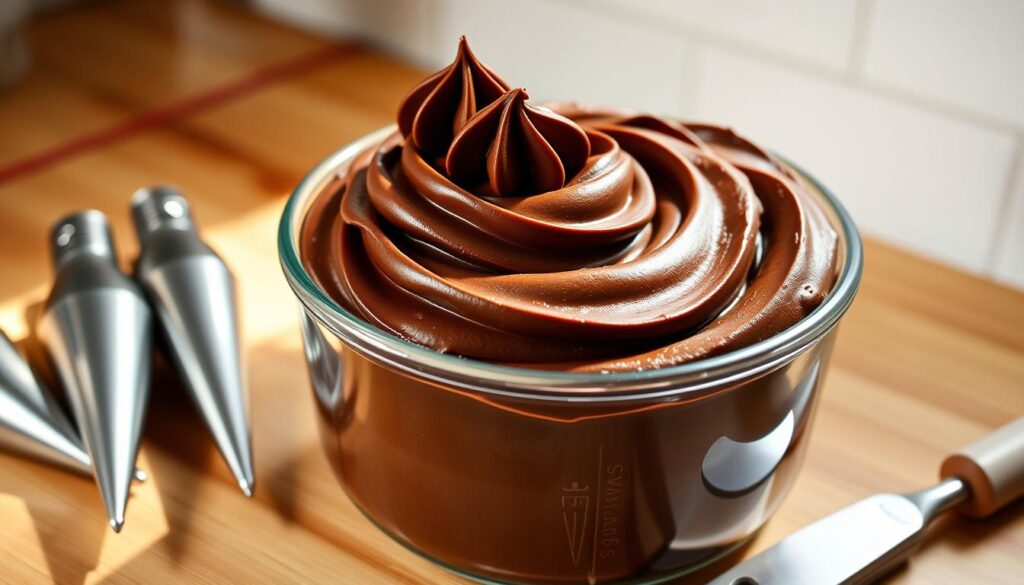
Keeping your chocolate ganache frosting fresh is important. It’s made with cream cheese spread. Follow these tips to keep it perfect.
Refrigeration is key to keeping your frosting fresh. Store it in an airtight container in the fridge for up to 5 days. This keeps it smooth and rich.
- Use a sealed container with a tight-fitting lid
- Place frosting in the coldest part of the refrigerator
- Keep away from strong-smelling foods
Freezing is great for longer storage. Your frosting can be frozen for up to 3 months. Here’s how to thaw it:
- Remove from freezer and place in refrigerator overnight
- Allow frosting to come to room temperature
- Whip briefly to restore original smooth texture
“The secret to perfect frosting is not just in making it, but in storing it correctly.” – Professional Pastry Chef
Temperature is key when working with cream cheese frostings. Always let your frosting come to room temperature before re-whipping. This makes it light and creamy again.
Pro tip: Never store frosted baked goods at room temperature for more than 2 hours if the frosting contains cream cheese.
Professional Piping and Decoration Methods
Creating stunning desserts with chocolate cream cheese spread is not just about taste. It’s also about how they look. Professional bakers use special techniques to make cakes look amazing.
When you master decorating, your cream cheese icing becomes a work of art. The right piping techniques can turn a simple cake into a masterpiece.
Selecting the Perfect Piping Tips
Choosing the right piping tip is key. Here are some tips from the pros:
- Closed star tips for elegant rosettes
- Open star tips for textured, voluminous designs
- Round tips for smooth, clean lines
- Petal tips for delicate flower patterns
Temperature Control Techniques
Temperature is important for keeping your frosting right. Here’s what the pros do:
- Refrigerate your piping bag for 30 minutes before decorating
- Work in a cool kitchen environment
- Keep frosting chilled between piping sessions
Advanced Decorative Approaches
Take your decorating to the next level with these tips:
- Gradient effect: Blend multiple chocolate shades
- Create textured surfaces using specialized tips
- Practice consistent pressure for uniform designs
With practice and patience, you’ll make your chocolate cream cheese spread look amazing. It will impress everyone at the table.
Conclusion
Making the perfect chocolate cream cheese frosting is an art. It needs patience and practice. Start by understanding the right mix of ingredients, temperature, and technique.
Quality cream cheese, premium cocoa powder, and precise mixing are key. They turn a simple dessert into a special treat.
This frosting is great for many desserts, from birthday cakes to elegant cupcakes. Each batch you make will improve your skills. It’s all about paying attention to detail and trying new things.
As you try new techniques and ingredients, your frosting will get better. Begin with the basics from this guide. Then, add your own twist. Soon, you’ll make frosting that wows everyone.
Your baking journey is special, and each try gets you closer to frosting perfection. Enjoy the process, learn from your mistakes, and savor the tasty results of your creativity with chocolate cream cheese frosting.

